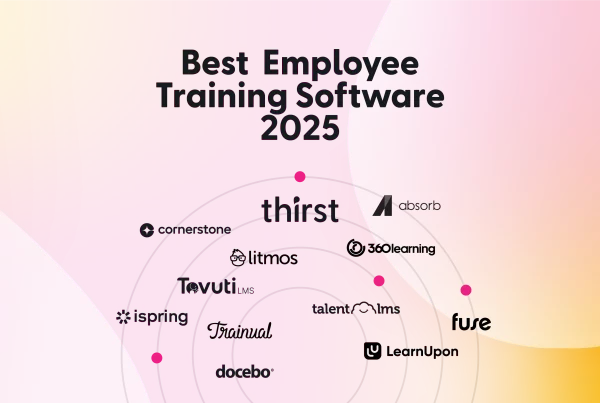As an L&D professional, it’s likely that one of your tasks will be to ensure employees within your organisation successfully complete a range of compliance training.
But, what exactly is compliance training? Why is compliance training so important? Keep reading and the Thirst team will answer these questions and more… 👇👇👇
1. What is compliance training?
Equality and diversity. International financial regulations. Health and safety requirements. Cybersecurity. Data protection.
Today’s businesses are expected to adhere to a veritable constellation of regulations, laws, and government policies. As the examples above illustrate, the types of regulations, laws, and policies that businesses are expected to adhere to can be very diverse. 📚🌎
Compliance training, therefore, refers to mandatory training that employees of an organisation or business are expected to complete. Compliance training is there to ensure that:
- Your business will operate in a way which is compliant with the applicable regulations and laws.
- You can demonstrate that your employees have been trained to work in a way which is compliant with the applicable regulations and laws.
- That your organisation can prove that training has been completed, should a breach of the applicable laws or regulations occur.
In other words, compliance training is there to protect employees and employers alike, and to demonstrate that as much has been done as possible to ensure the company – and the way in which it does things – is compliant. 👍
Note – an important point to note regarding compliance training is that it is almost always mandatory. That’s why it’s super important for companies to find the best possible way of delivering and recording completion of training.
2. What is compliance learning?
When reading and researching the topic of compliance, you may encounter the term ‘compliance learning’. 🤔
Compliance learning is effectively the same thing as compliance training, and is often used interchangeably with this latter term.
As such, compliance learning refers to the same thing as compliance training. That is, compliance learning refers to the process of training your workforce so that they understand the relevant laws, regulations, and policies that directly govern how they should be doing their jobs. 🎯
3. What is the role of a compliance officer?
Depending on the scale of your business, you may have a full-time compliance officer. 🧑💼
A compliance officer is an individual who is responsible for ensuring that all of a company’s policies and actions comply with the relevant laws and regulations.
It’s the job of the compliance officer to stay informed of all regulations and laws that impact the company and to ensure these regulations are reflected in the way the company trains employees. ✋
Whilst the compliance officer is typically a stand-alone role, by its very nature you’ll typically find that a compliance officer works very closely with the learning and development department.
4. What types of compliance training are there?
As we mentioned earlier, there are numerous types of compliance training that companies are expected to deliver to their employees. However, we understand that simply saying ‘many types’ is a bit vague. 😕
So, to provide some context, we’ve set out some of the most common types of compliance training below.
Health and safety compliance training
In the majority of countries, companies are expected to provide their employees with comprehensive levels of health and safety training. 🏥
Depending on the work environment, the type of training will vary.
However, as a minimum, you’ll find that the majority of companies expect their employees to complete health and safety compliance training that covers:
- An introduction to health and safety in the workplace and best practices.
- How to report an accident or incident in the workplace.
- Training on emergency procedures.
- How to use PPE (personal protective equipment), if applicable.
Depending on the industry in which the company operates, this training may be supplemented with additional training modules. This is particularly true for companies that operate in hazardous environments etc.⛏️👷
Data protection and privacy compliance training
Data breaches. They’re never a good thing. And, when they’re big enough, they can make headlines in the national press. 📰🗞️
It’s for this reason that data protection and privacy training is often the highest-priority form of compliance training in many companies.
Data protection-focused compliance training has become an even bigger priority for companies since the European Union introduced its GDPR (General Data Protection Regulation) legislation, which sets out fines of up to €10 million for companies that breach the provisions of the regulation. 🤯🤯
The average data protection and privacy compliance training will cover areas such as:
- How personal data should be handled and stored.
- Cybersecurity best practices.
- What to do in the event that a data breach does occur.
Anti-discrimination and diversity training
Recent years have seen an increased emphasis on anti-discrimination and diversity training within the workplace. In fact, in some international jurisdictions, providing employees with training on equality and diversity-related issues has become mandatory. 🎯
Anti-discrimination and diversity training will typically cover areas such as:
- Awareness of issues directly related to race, gender, and sexual orientation.
- How to identify and combat discrimination related to these issues within the workplace.
- How to report inappropriate behaviour in relation to equality and diversion.
Anti-bribery compliance training
In many international jurisdictions, it’s necessary for companies to provide their employees with anti-bribery training. This is often particularly true for businesses that work on an international basis, that facilitate cross-border trade. 💰💸
Anti-bribery compliance training will usually cover areas such as:
- How to identify bribery and the different types of bribery.
- The consequences of (advertently or inadvertently) accepting a bribe in different jurisdictions.
- The differences between a bribe and a gift.
- How to correctly declare the receipt of gifts.
5. Why is compliance training important for companies?
So far, you’ve probably gathered that compliance training is kind of a big deal for companies. But, is it really that big of a deal?
Our answer is an emphatic ‘yes’. 😀
Don’t just take our word for it, though. When you consider that there has been a 45% increase in the cost of non-compliance related events since 2011, it pays (literally!) to take compliance training seriously.
Below, you’ll find some of the most significant benefits of compliance training and – by extension – why it’s so important for companies.
Compliance training reduces the risk of non-compliance
Should your company be found to be in breach of a particular piece of legislation or regulation, it can be liable for millions of pounds in fines. 😲⚡💵
That’s not something any company wants to deal with.
By training your employees, compliance training reduces the risk of these scenarios arising.
Plus, should a breach of a regulation actually occur, a well-documented compliance training programme can help a company show that they’ve made the best possible effort to be compliant. 🖊️📝
If that’s not enough to convince you, consider the fact that businesses lose an average of £3.5m in revenue due to a single non-compliance event (Globalscape).
Compliance training can create a safe, inclusive working environment
By informing your employees about best practices in health and safety, data protection and equality and diversity, compliance training can help companies foster a safe and inclusive working environment. 📝
By highlighting important issues – such as discrimination in the workplace – compliance training can encourage employees to speak up in the event that they do spot (or experience) such an issue.
This creates a proactive attitude within the workforce, and as a result, helps you create a much more inclusive workplace. 😊
Furthermore, compliance training can enhance your company’s reputation. Offering quality compliance training reinforces the impression that you are a company that cares about staff development and progression. 😎
Compliance training helps companies define organisational policies
By being aware of best practices in areas such as equality and diversity and data protection, compliance training can help companies shape their own internal policies. 📁📂
By aligning things like their internal policies and the employee handbook with compliances best practices, you can effectively ‘ingrain’ compliant ways of working within your business.
Plus, by ensuring that compliant ways of working are embedded within your company policies, you can speed up decision-making – as employees will know what ways of working are acceptable, and know how to act without fear of being penalised. 🤗
Compliance training can boost the bottom line
When delivered correctly, compliance training can boost the underlying financial performance of a company. 📈🤑
How? Well, it’s quite simple, really.
In the most direct and immediate sense, compliance training can reduce the likelihood that your company breaches regulations and laws – thus avoiding costly fines or other actions.
Given the sums that can be involved, this isn’t an insignificant point! 🫰
Additionally, compliance training can help you retain the best people in your company. After all, you don’t want to lose an employee because they’ve made a compliance-related mistake through ignorance. Compliance training reduces the likelihood of such an issue occurring.
Plus, when you consider that 23% of companies don’t have a formal compliance training plan in place, you can gain a competitive advantage by being a company that does. 😲
By demonstrating a strong record of compliance, you’re far more likely to pick up new contracts and win business!
Compliance training provides evidence
Should the worst happen and your company comes under investigation for the breach of a regulation, law or policy, having a robust and well-documented compliance training programme will be your best form of defence. 🚨🚨
Compliance training allows you to demonstrate (both internally and externally) that your company is committed to doing things the right way.
This is good, not only from a reactive perspective, but a proactive one. With everyone in the company confident that you are doing things compliantly, they’ll be able to carry out their jobs with more gusto and confidence in general. 💪💪
6. How to make compliance training fun and engaging
Mention the words ‘compliance training’ to your employees, and you’re likely to be met with the rolling of eyes, ‘sighs’ and multiple excuses about having to go to a doctor’s appointment…
But, compliance needn’t be soul-destroying or boring. 😭😭
It’s all about using the right platform to deliver that training.
Below, we’ve set out some key ways you can make compliance training more fun and engaging.
Allow people to learn on their own schedule
Traditionally, compliance training would involve employees having to take an hour or two out of their workday to sit at a desktop computer and complete an online course.
In today’s fast-paced working environment, that’s not always convenient (for employees and employers alike). ⏳
Instead, you should consider using a learning experience platform (LXP) that allows employees to fit their compliance training in around their workflows. This type of ‘bite-size’ learning is often more effective than forcing employees to complete compliance training in one or two-hour chunks. 😄
Provide compliance training in various formats
Compliance training doesn’t necessarily have to involve reading reams and reams of written information.
Instead, you can make compliance training far more attractive and digestible by providing information in different formats. 🖥️📱📖
For example, you may choose to provide compliance learning modules in the form of audio files (so people can listen on the go), videos (for people who may struggle with large amounts of written text), or gamify it by turning the learning content into quizzes etc.
Whatever form it takes, by providing your compliance training in various content formats, you can significantly increase uptake and completion rates. 📊
Personalise your compliance training
Just like any other form of training, compliance training doesn’t necessarily have to be a ‘one size fits all approach’.
Depending on your company – and what it does – you may not need to provide the same compliance training to all employees. 📏
If that’s the case for your business, then you’ll benefit from using an AI-powered skills platform. Such a platform allows you to tailor your compliance training so that each employee is offered only relevant training modules. 🎯
This has the benefit of making employees more engaged with the training, whilst also improving uptake and completion rates. 🔥
7. How often is compliance training required?
Compliance training is very rarely a ‘one and done affair’. In fact, the vast majority of compliance training needs to be carried out on at least an annual (sometimes more frequent) basis. 📅
This means it’s vital that you have a truly effective compliance training delivery platform in place.
As we’ve seen, not only do you require a delivery platform that makes compliance training fun and easy, but you need one that allows you to closely monitor and log completion rates.
That compliance training platform is Thirst. 😎💯
An AI-powered learning and upskilling platform, Thirst is a powerful way to deliver compliance training that your employees will love using.
As one of the fastest ways to learn new skills, over 100 L&D teams trust Thirst to deliver their compliance training in a high-impact way.
Want to try it for yourself? 👇👇👇
Then get a free 1:1 demo of the Thirst platform now.
For more e-learning insights, resources and information, read the Thirst blog…
The Ultimate Guide to Faster Employee Onboarding | 7 Ways to Identify Knowledge & Skills Gaps in Your Workforce | Skills vs Competencies: What Are the Key Differences?







